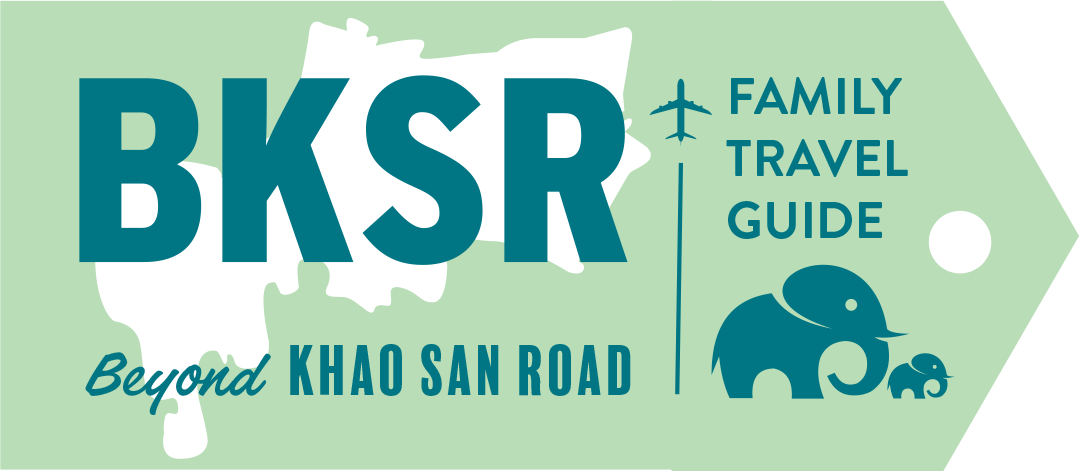Visiting Santa Cruz Galapagos with kids opens the door to an extraordinary world brimming with mesmerising wildlife and scenic wonders. As the central hub of the Galapagos Islands, Santa Cruz offers families a perfect blend of adventure and education, set against a backdrop of stunning landscapes and unparalleled biodiversity.
A family vacation to Santa Cruz promises unforgettable close encounters with nature, making it an ideal destination for families looking to foster curiosity and a deep appreciation for the natural world in their children.
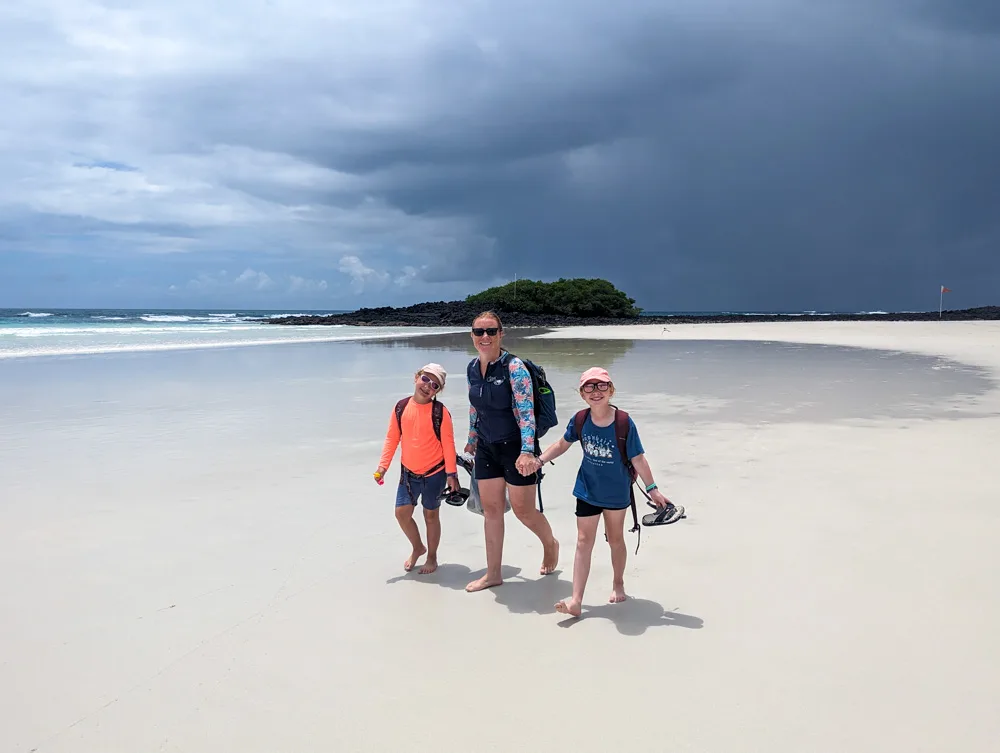
From the giant tortoises at the Charles Darwin Research Station to the pristine beaches of Tortuga Bay, Santa Cruz invites young explorers and their parents to engage closely with the unique wildlife and ecosystems that make the Galapagos a living laboratory of evolution and somewhere for an incredible family vacation.
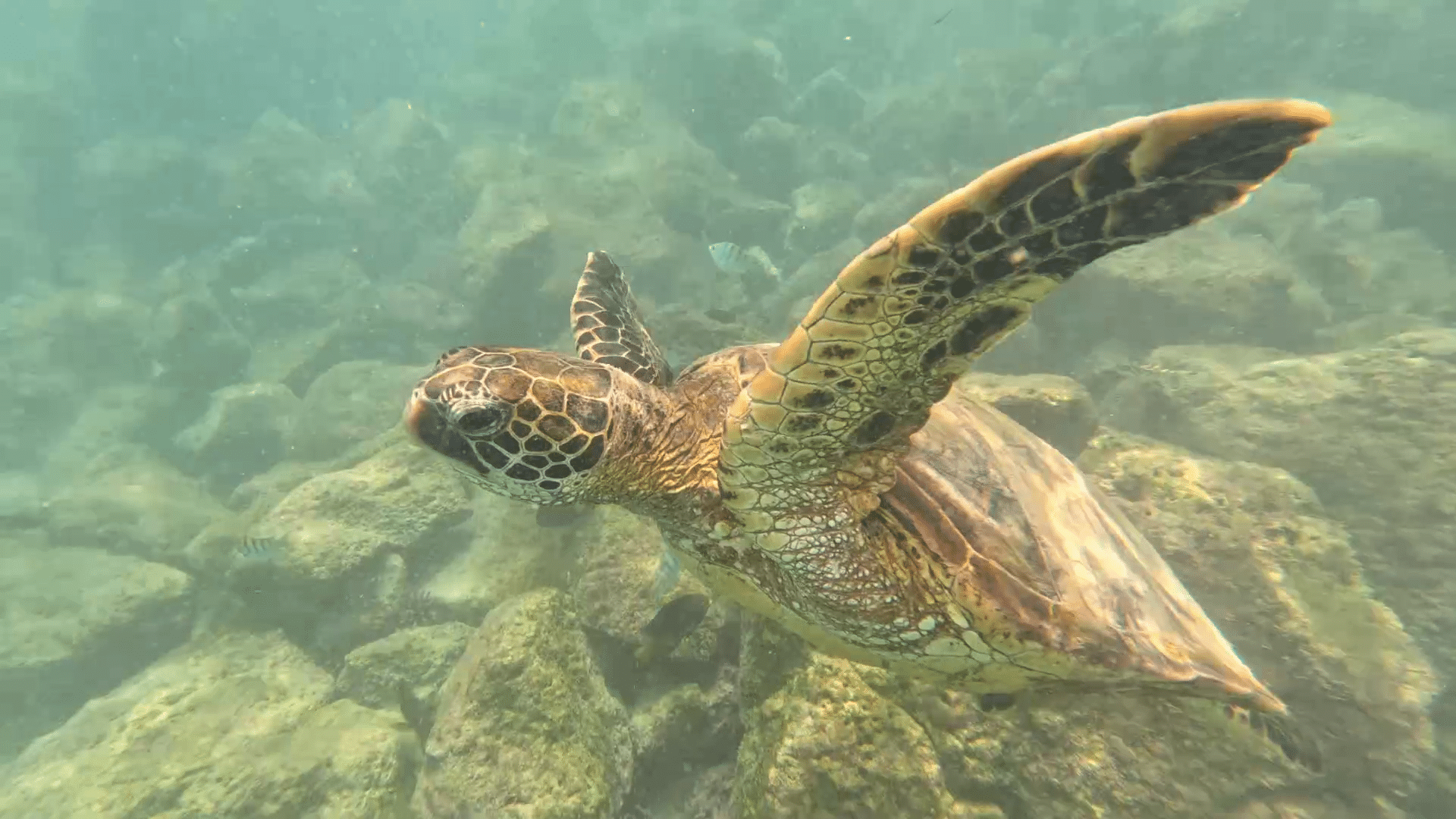
The main town in Santa Cruz, Puerto Ayora, has everything you need for a welcoming and comfortable stay. Excellent restaurants with local and international cuisine, cosy accommodations ranging from boutique hotels to family-friendly hostels, and a vibrant market selling local crafts and fresh produce are just the beginning.
It’s a place where the ease of modern amenities meets the charm of island life, ensuring that families can access both convenience and local culture. Whether dining on freshly caught seafood, exploring the bustling waterfront, or simply enjoying the laid-back pace, Puerto Ayora provides a perfect base for your Galapagos adventure.
Our Map For Exploring Santa Cruz Galapagos With Kids
When To Visit Santa Cruz Galapagos With Kids
The ideal time to visit Santa Cruz, Galapagos, with kids is from June to November when the weather is cooler and dryer, making it more comfortable for outdoor activities.
During these months, the ocean is calmer, meaning smoother boat rides and better conditions for snorkelling and diving.
Wildlife viewing is exceptional year-round, but these months offer unique opportunities to see migrating whales. Additionally, this period avoids the December to May rainy season, ensuring more sunny days for your adventures.
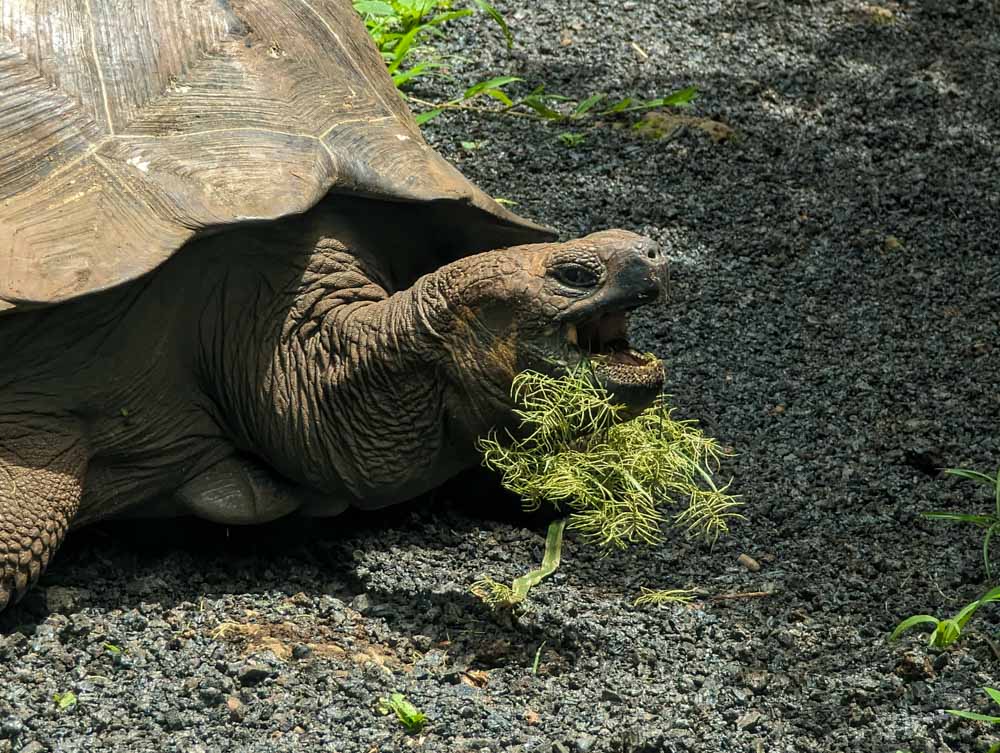
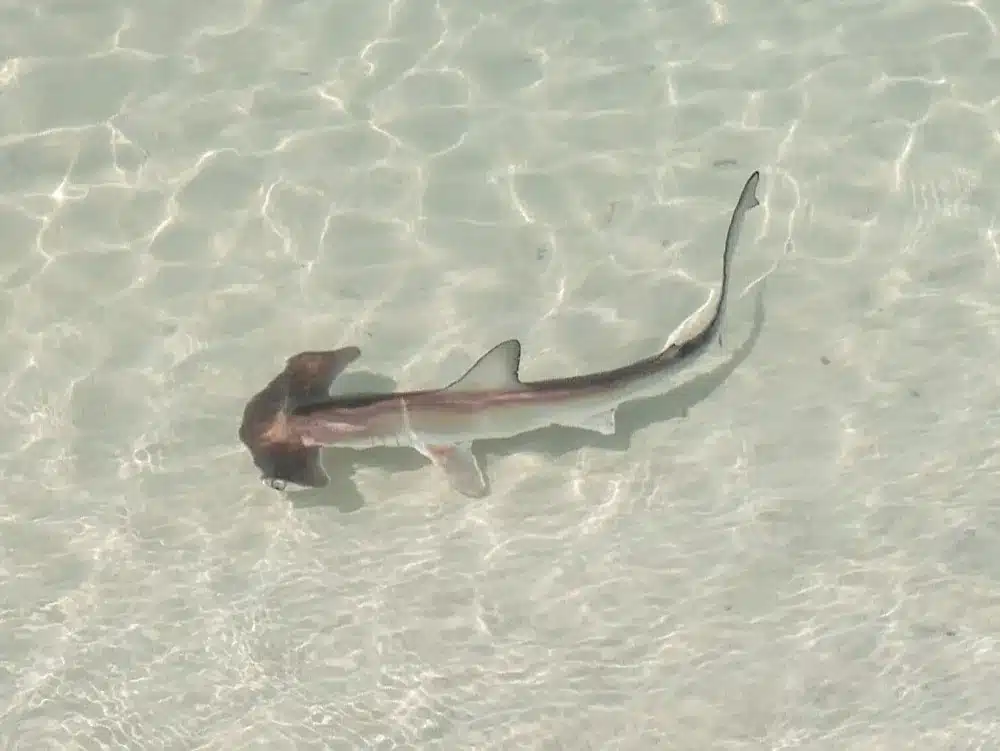
We visited in February, and although it was certainly hot and humid, we still had an incredible time on the islands. June to November is the ideal, but other seasons still have much to offer.
What To Pack When Visiting Santa Cruz Galapagos With Kids
Aside from the obvious, like sunblock and bug spray, we would recommend bringing a few more things. Check out our Essential Packing List For Visiting The Galapagos Islands With Kids here.
Getting To Santa Cruz Galapagos With Kids
For such a popular destination, reaching the islands is a little complicated. A combination of geography and the government’s careful protection of the ecosystem means that there is a bit more to do than simply boarding a flight.
We have written a complete guide on flying to Santa Cruz, Galapagos, with kids here.
What Age Is Best To Visit Santa Cruz Galapagos With Kids
On our recent Galapagos family trip, we travelled with our eight and nine-year-old daughters, which we think was a great age to explore the island and appreciate the wildlife and geology.
If they were much younger, the heat and walking would have been too much for them, and some of the activities, like snorkelling, may have been overwhelming.
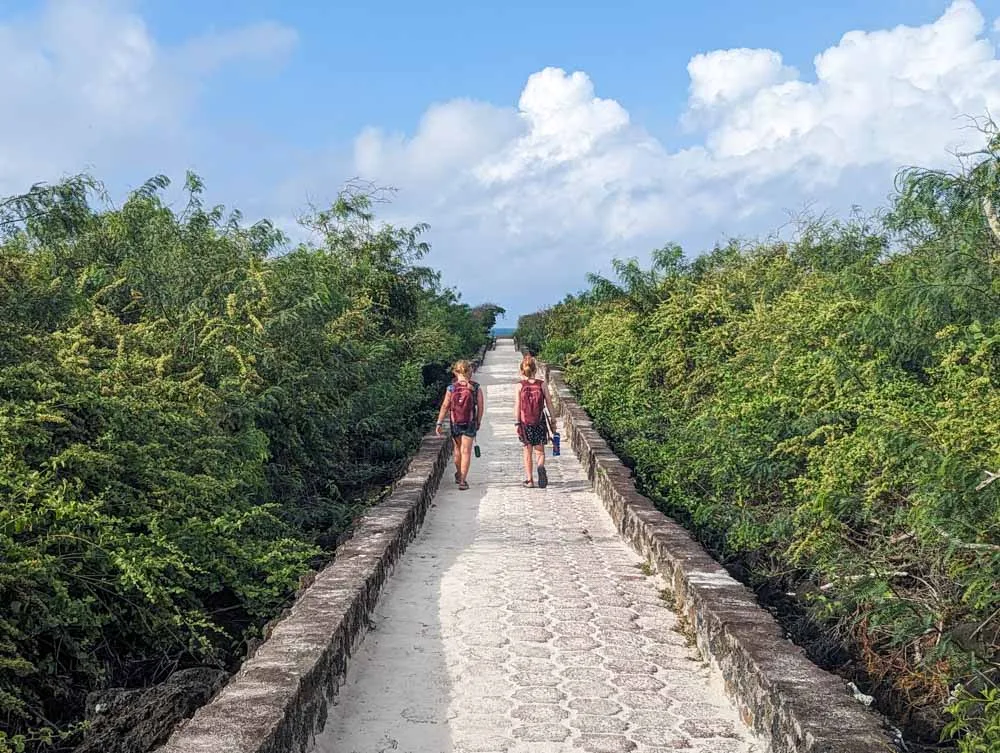
That said, if you want to dive with your children, the youngest age we could find that would be accepted on a tour is 12.
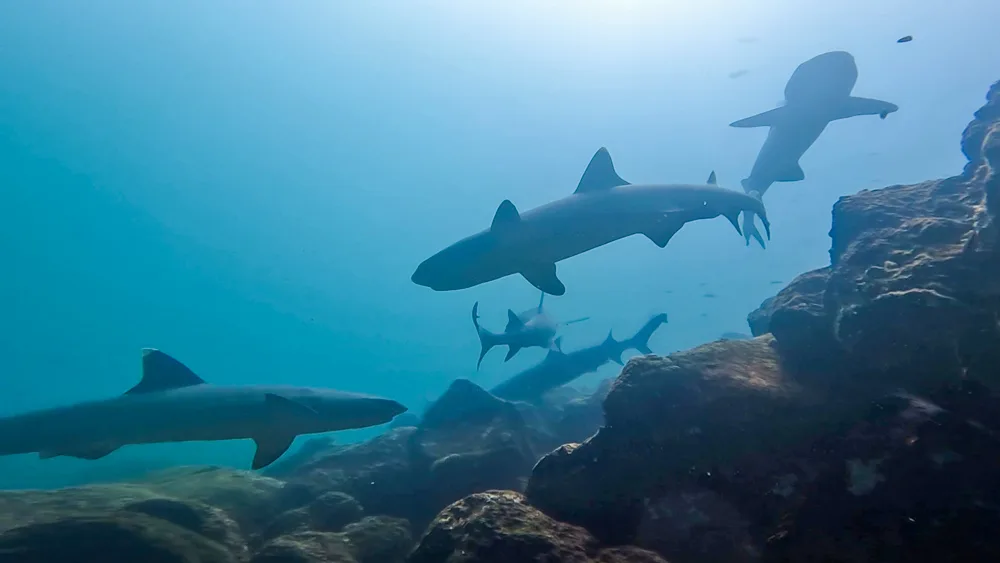
Where To Stay And Eat in Santa Cruz
While there are several hotels towards the centre of the island, the vast majority of places to stay are in Puerto Ayora, which is the main town of Santa Cruz.
Puerto Ayora has a ramshackle island charm, and for visitors, the heart of the town is Av Charles Darwin, which runs along the seafront. Here, you will find great hotels, beautiful restaurants and bars, and shops selling local hand-crafted souvenirs.
Also, this is where you will find other useful things like cash machines, a well-stocked supermarket, places to purchase tickets and day trips directly from the vendors, and the Gus Angermeyer Pier, where most tours and water ferries depart.
Puerto Ayora is very compact and walkable; if you stay anywhere near the seafront, you will be at most 10 minutes away from anything you could need.
If you venture just a few roads back, you will find slightly less touristy offerings, including excellent hostels and restaurants.
Our food highlight of Puerto Ayora was the row of family-run restaurants on Charles Binford (or, as we called it, Harassment Alley; you will understand why when you visit!), offering incredible local cuisine for $5 for two courses. We ate here three times and had sumptuous local delicacies like locro de papa soup and scorpion fish. If this doesn’t sound appealing to your kids, don’t worry; they also have Western food choices.
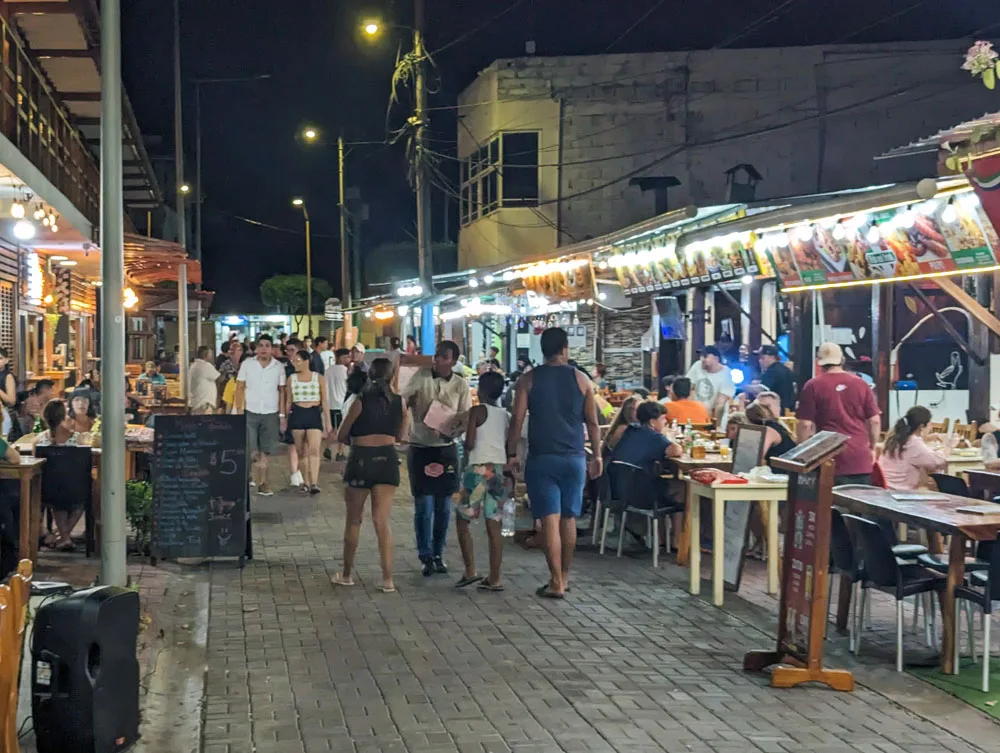
If you want to go a little more upmarket, head to the seafront restaurants. The kids’ favourite was TJ’s, which offered local dishes and a great children’s menu. Parents’ favourite was The Rock Galapagos, which had fantastic local beers and great dining. Finally, the Golden Prague Pub is the most touristy restaurant in the town but has good food and some great beers.
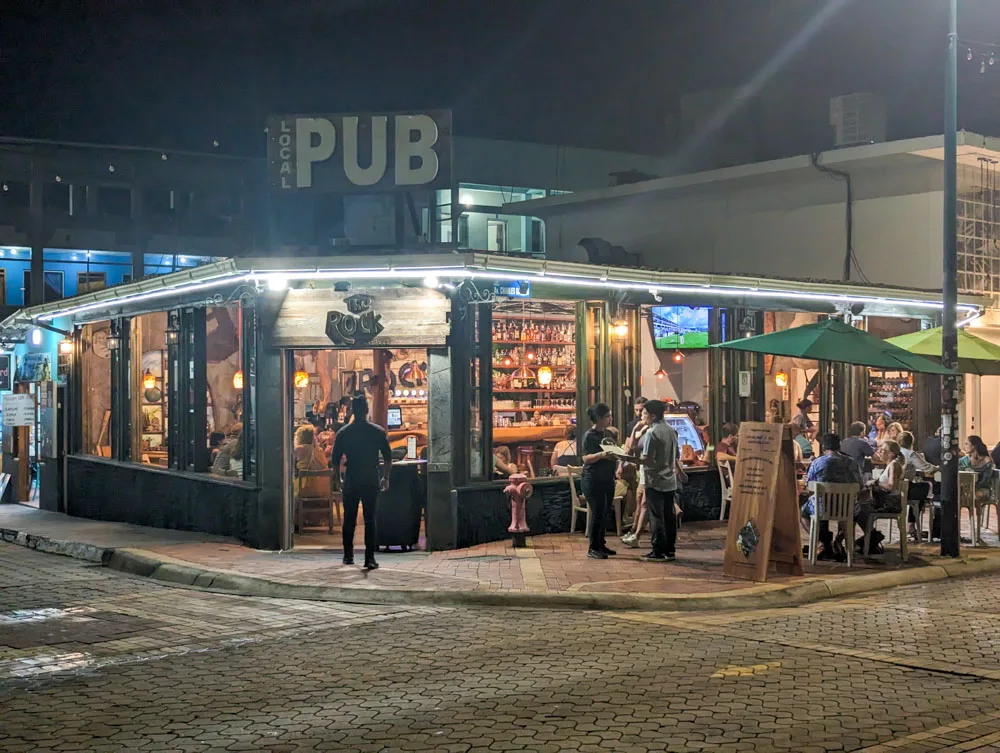
Why Cash Is (Sort Of) King In Santa Cruz
Before arriving in Santa Cruz, we had read that virtually nowhere takes bank cards and to expect to pay for everything in cash. This was not the case in Puerto Ayora, where many of the hotels, large supermarkets, pharmacies, major tour operators, and seafront restaurants take credit cards.
However, some of the gift shops and smaller local shops only take cash, and if you head out of the main tourist strip, then it is likely that bank cards will not be accepted. We also found water taxis, and the restaurants on Charles Binford will only take payments in cash. Finally, if you plan to catch a ferry to another island, you can only pay the municipal fees in cash.
We also found if you want to pay on a credit card for an excursion some tour operators add pretty hefty fees for doing so, up to 25% in some places. If that is the case, getting cash out of the ATM may be cheaper.
When visiting the island, bring plenty of small denomination bills with you. We had issues paying a $30 bill with a $50 note. It is a mystery to us how a local economy that runs largely on cash never seems to have any change. The $20 bills we brought were widely accepted for most payments.
Getting Cash In Puerto Ayora
If you need to top up your cash, the main bank of ATMs in Puerto Ayora is near Proinsular Market and Gus Angermeyer Pier, where you will find a bank with three ATMs next to each other.
All three charge fees to use, but when we checked, the light blue “Banco Bolivariano” machine in the middle was the cheapest, charging just $2 for a withdrawal of up to $300.
There are also other cash machines further along Charles Darwin Ave at Banco Del Pacifico near Santa Cruz Brewery.
We had no issues using these machines, but we have heard that they can run out of cash, and they put limits on withdrawals if they are running low.
The other option to get cash in Puerto Ayora is to send it yourself via Western Union. Before visiting Patagonia, for us Western Union was synonimous with Nigerian Scammers but it turns out it is actually quite useful! You can send yourself money using the app for fee of around $5.
There is a Western Union just to the right of the cash points. When we visited, the maximum they could release in one go was $5000, but check what they have available before forwarding yourself funds.
Where to Find Medical Attention In Puerto Ayora
We had the misfortune of needing some (very minor) medical attention while in Puerto Ayora but found it very easy to be seen by a doctor.
For accidents and emergencies, the local Hospital “Republic of Ecuador” is near the Gus Angermeyer Pier. When you walk in, the main reception can point you where you need to go. Patients are triaged, so you may not be seen in the order you arrive. If your requirement is not urgent, then you may be waiting a few hours. Treatment here is free at the point of use.
Alternatively, if you just need to see a doctor, then a short walk up the road from the hospital next to the Movistar shop is Centro Medico. This a new, modern facility and Adrian was seen very quickly by a doctor for $30.
There is no shortage of pharmacies in Puerto Ayora with at least half a dozen on Charles Darwin Av alone. All of them carry sunblock and other essentials.
Staying Hydrated When Exploring Santa Cruz
Coming from cold, wet Manchester, the heat and humidity of Santa Cruz Galapagos was a shock. We knew it was going to be hot, but not that hot!
Ensuring your kids stay hydrated is crucial while travelling (see our guide on recognising heatstroke signs), and this is especially difficult in the Galapagos due to the hot climate and because tap water isn’t safe to drink.
To make things a bit trickier, the Ecuadorian government has banned single-use plastics, making bottled water hard to find.
Fortunately, many hotels and hostels offer free drinking water, allowing guests to replenish their reusable water bottles. This eco-friendly approach helps the environment and saves money.
When getting ready to visit Santa Cruz, remember to pack good-sized water bottles for each family member! We found we could easily drink a litre of water each just walking around the town.
Additionally, we also packed rehydration salts, which proved invaluable. The intense heat can lead to significant salt loss through sweating, so having the means to replenish vital electrolytes after a sunny day at the beach was incredibly beneficial.
Getting Online in Santa Cruz
The internet is a rare commodity in these parts!
We used e-sims from Airalo that connected to Movistar and gave us coverage on the populated parts of the island. This was enough to use WhatsApp and Google Maps, but nothing more.
Most hotels provide WiFi, but don’t expect it to be fast.
That said, we saw one Airbnb offering Starlink Internet – hopefully, this catches on!
Travelling Between Santa Cruz, Isla Isabela and San Cristobal.
If you want to travel to Isabela Island to see the beautiful beaches of Puerto Villamil or to San Cristobal Island, all ferries depart from Gus Angermeyer Pier. We have written complete guides on how to book tickets and how to make the most of the journey:
Taking The Ferry Between Santa Cruz and Isla Isabela With Kids
Catching The Ferry To San Cristobal Island
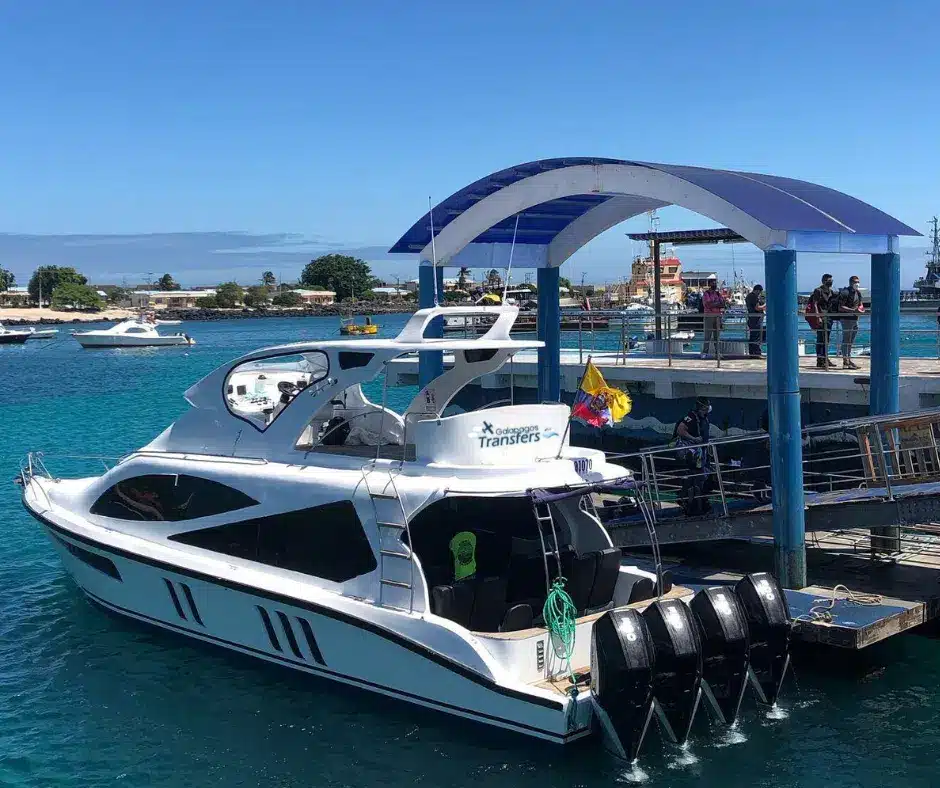
Things To Do In Santa Cruz Galapagos With Kids
In Santa Cruz, Galapagos, families with kids can look forward to an array of unforgettable adventures. Whether it’s diving alongside sharks, trekking through lush highlands, or getting up close with giant tortoises, the island offers diverse experiences that captivate both young explorers and adults alike.
Spot Sting Rays in Tortuga Bay
This was our first trip after arriving in Santa Cruz, and wow, what a way to start! The journey to Tortuga Bay offers a beautiful walk to a pristine white sand beach and the chance to get up close to marine iguanas, pelicans, sting rays, and baby sharks. All of this is topped off with a boat ride home from the beach; this has everything!
Georgia and Eva had an incredible day and were delighted to see baby hammerheads and reef sharks in their natural habitats and more than happy to get some beach time!
If you are planning snorkel trips, this is an excellent place to teach your children what to expect if they are unfamiliar with swimming in the ocean, as the water at Playa Mansa is very calm, if not very clear.
Check out our guide on exploring Tortuga Bay Galapagos with kids.
Visit The Gus Angermeyer Pier At Night
This is one of Eva and Georgia’s favourite activities!
After a delicious evening meal, be sure to walk down to the Gus Angermeyer Pier to take in the marine wildlife.
At night, the water here is swarming with sea lions, baby sharks, golden rays, and other marine life drawn by the harbour lights.
You can usually see the occasional luxury yacht or cruise ship here, too!
It is incredible how accessible the wildlife of this island is.
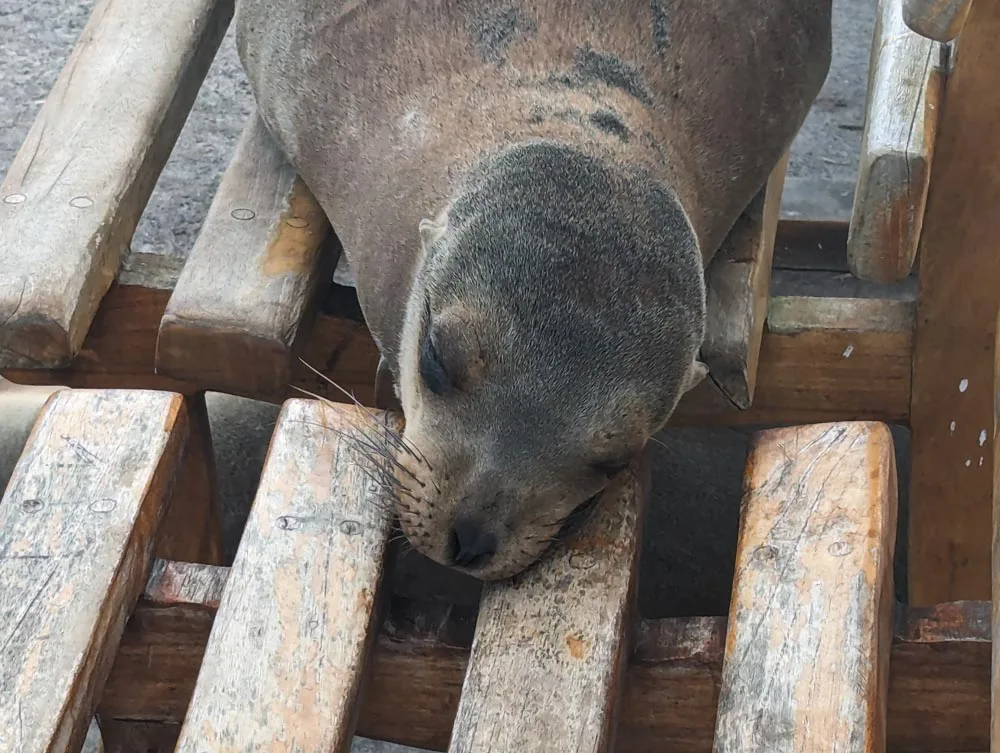
Explore The Coast on The Bahia Tour
This is a great half-day tour that touches on Santa Cruz’s diverse geology and some incredible wildlife, including blue-footed boobies and sea turtles. It also and takes you to great snorkelling spots around submerged volcanic rocks, including the unique rock formation Las Grietas.
You can read our full Santa Cruz Bay Tour guide here.
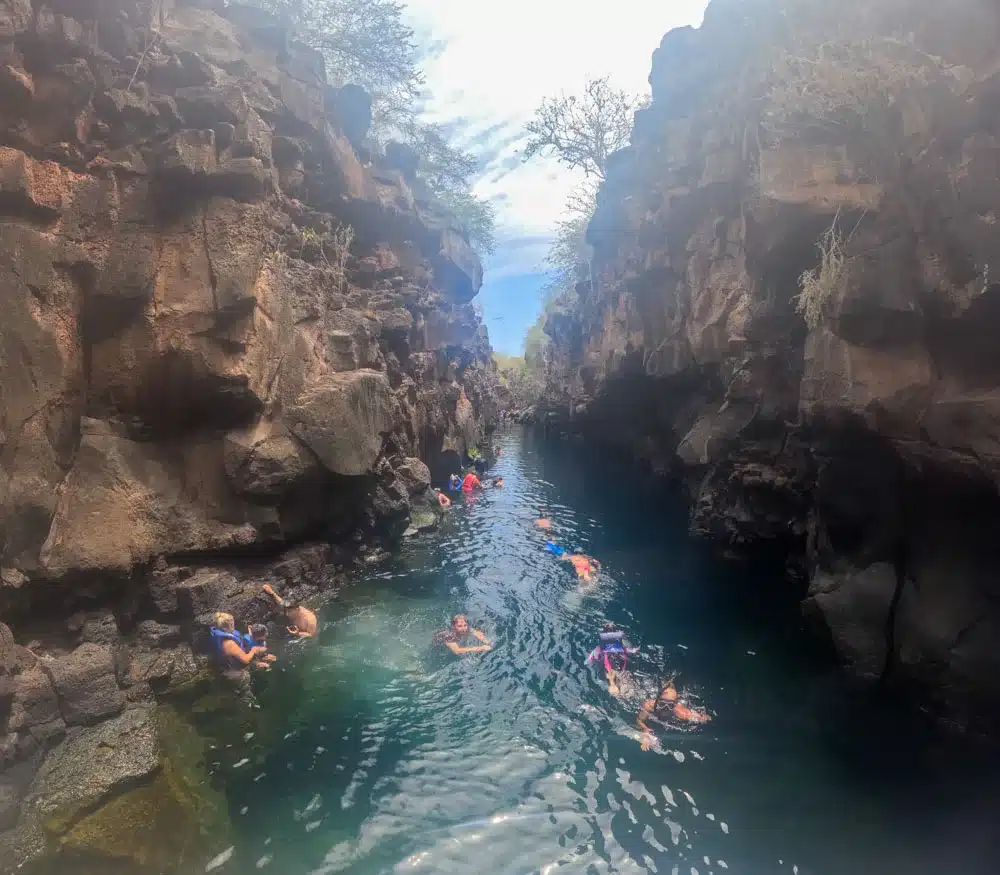
Enjoy A Family Diving Trip
For children over the age of 12, then a Discovery Diving Trip will bring you all up close to giant schools of fish, gliding sting rays, and shivers of sharks (yes, we had to Google what a group of sharks is called!)
Even if you have never dived before, then experienced dive masters can guide your family through all they need to know. You can read our full guide to diving with kids In Santa Cruz here.
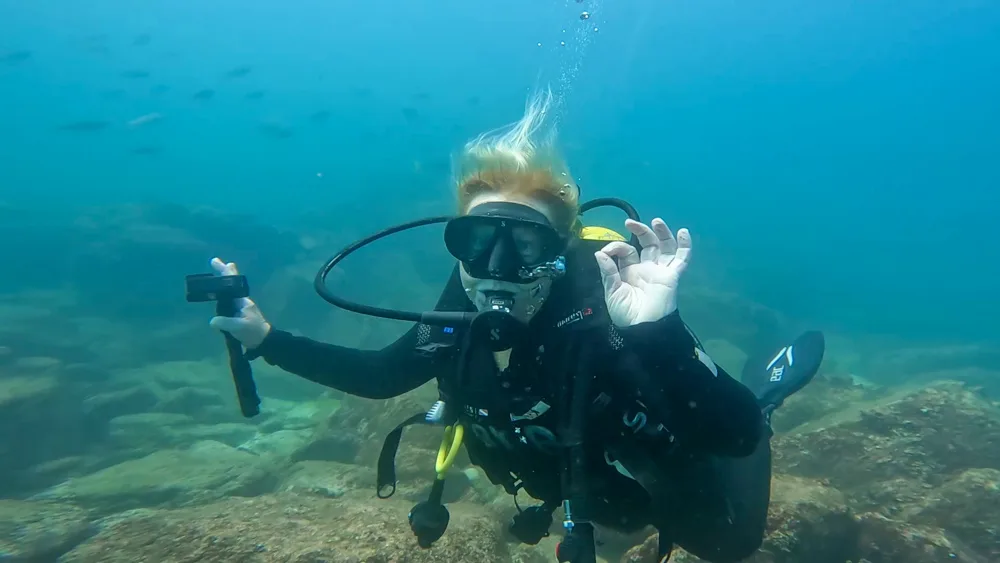
Head Inland on the Highlands Tour
If you want a family trip to explore some of Santa Cruz’s interior, including “Los Gemelos” and lava tunnels and get face-to-face with giant tortoises at a tortoise reserve, then this half-day trip is a must. You can read our full Highlands Tour guide here.
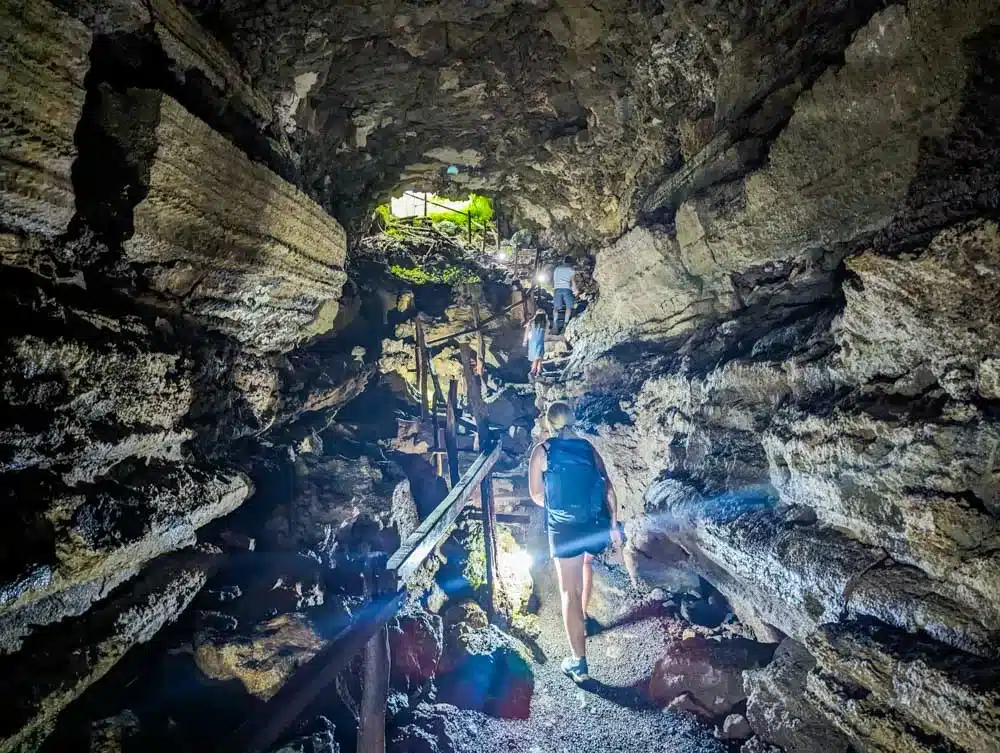
Shop For Beautiful, Locally Made Art and Souvenirs
Puerto Ayora is filled with dozens of souvenir shops (known to us as “tatteries”), all selling the same t-shirts, key rings and “I Love Boobies” hats.
Even the optimistically named “Artisanal Craft Market” has the same trinkets and tat on display.
However, if you look, some beautiful galleries are selling reasonably priced art that was handcrafted right here in Santa Cruz. Often, you get to meet the artist as it is they who are running the shop!
We found three galleries we loved which were very close together:
- Angelique Art Gallery – This gallery is worth a visit if only to admire the incredible mosaic floor created by the owner, Sarah Darling. Here you will find beautiful depictions of local wildlife,
- Opuntia Ceramics – Specialising in ceramic art, we could have bought up about half the gallery! The only problem is how to get it all home.
- Coffee Art Gallery – This gallery does not even have a name, as far as we can tell! All the artwork of local animals is created by a local lady using mainly local coffee; we loved its authenticity.
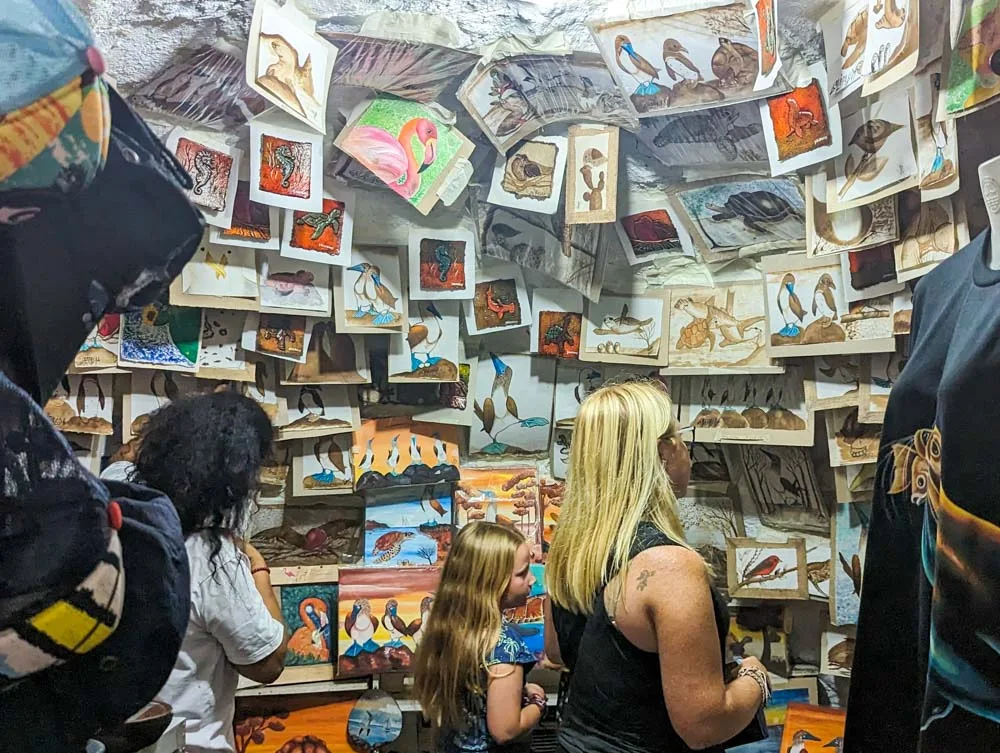
Combine Education and Fun at The Charles Darwin Research Station
The Charles Darwin Research Station on the east side of Puerto Ayora is a cornerstone of conservation efforts in the Galapagos and an educational goldmine for families. We try to “educate through astonishment”, and the Charles Darwin Centre does this brilliantly!

Visiting with kids offers a firsthand look at the station’s critical work in preserving the unique ecosystems of the islands. The centre is also home to breeding programs for giant tortoises and land iguanas, providing a rare opportunity for children to come face-to-face with these ancient creatures, understanding their life cycles and the conservation challenges they face.
The centre is very engaging, with interactive exhibits and informative displays exploring evolution through natural selection and the role of scientists in fighting invasive species.
As you approach the centre, you will pass “Ruta De La Tortuga” – this is a great place to get up close to the incredible giant tortoises that inhabit the islands. You can only do this with a guide at a cost of $10 each, no discount for children. Tours run every 45 minutes, starting at 08:00 and finishing at 16:45.
We had already seen a lot of the tortoises on the Highlands Tour and on Isla Isabela, so we walked on to the main centre.
The main Research Station, with its great exhibits, is a short way further up the road. Here, you will also find toilets and a moderately overpriced cafe. One cool thing was that there is a model of HMS Beagle here; we had explored a full-sized replica at Museo Nao Victoria in Punta Arenas!
After visiting the research station, you can then turn left and walk up to the Lonesome George exhibit and see some rescued tortoises and the incredibly cute baby giant tortoises, the result of the centre’s breeding program.
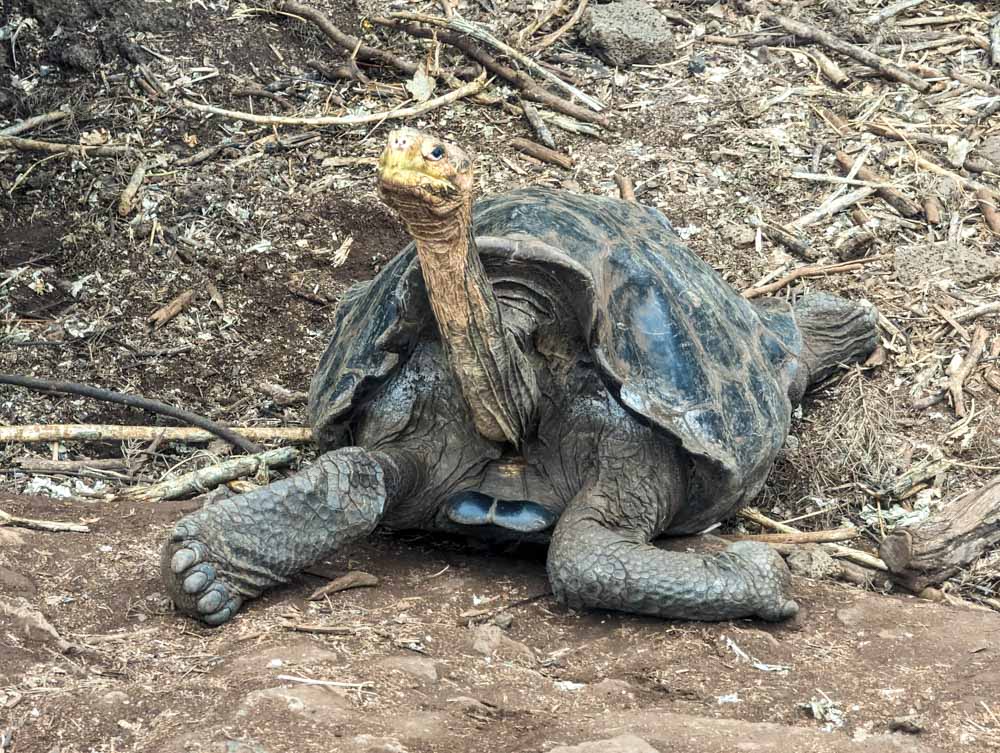
The Charles Darwin Research Station, combined with a trip to one of the nearby beaches of Playa de la Estacion and La Ratonera, is enough to fill a very happy day indeed!
Relax on Playa de la Estacion and La Ratonera
Visiting La Ratonera and Playa de la Estación with kids is a delightful experience that combines adventure with natural beauty.
La Ratonera, with its intriguing lava formations, offers a fascinating glimpse into the volcanic origins of the Galapagos Islands, perfect for little explorers with big imaginations.
Just a short walk away, Playa de la Estación presents a serene beach setting where families can relax and play in the gentle waves. It’s also an excellent spot for snorkelling and wildlife viewing, with frequent sea lion sightings.
There are no facilities at either of the beaches, but toilets and a cafe are just a short walk away at The Charles Darwin Research Station.
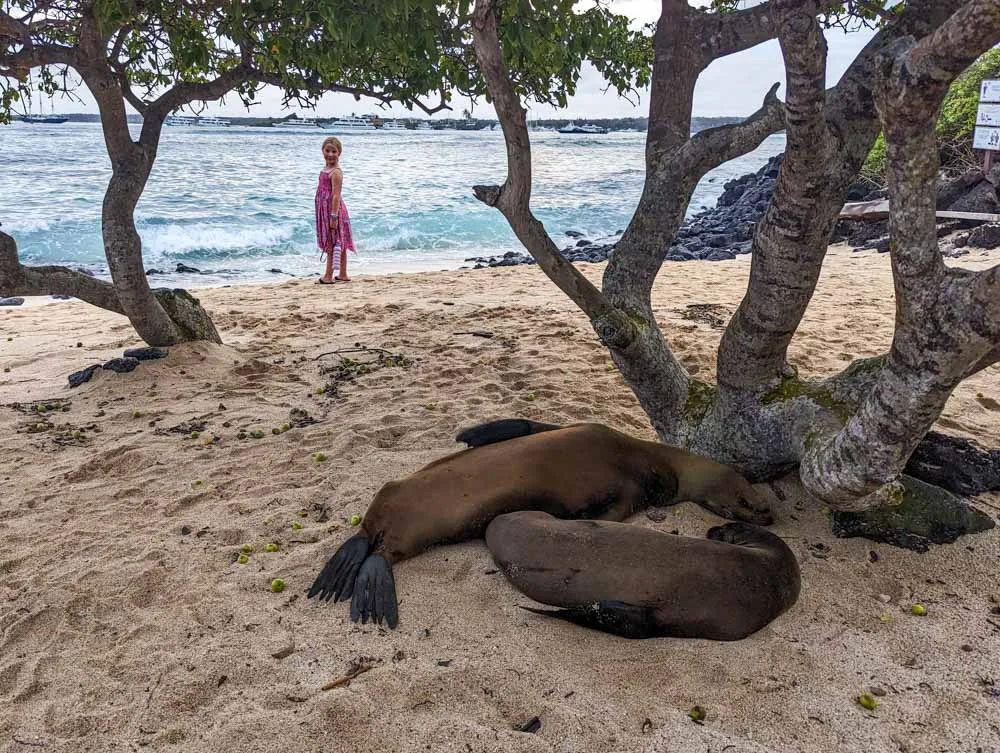
See The Flamingos of The Nimphs Lagoon
The Nymphs Lagoon, a serene haven nestled close to Puerto Ayora, offers families a magical encounter with its resident flamingos. This tranquil spot is a spectacle of nature where these graceful birds can be seen wading through the shallow waters.
The lagoon’s easy accessibility makes it a must-see for any family exploring Santa Cruz.
One Thing (Probably) Not To Do In Santa Cruz
Origins: Museum of Nature
This “museum” was something of an unwelcome surprise.
Origins: Museum of Nature explores the biblical, creationist worldview rather than Darwin and Wallace’s evolutionary theory. The museum explores the belief that all life was created in its current form and did not evolve, a view not supported by the vast body of scientific evidence from disciplines including biology, geology, and astronomy.
While I have no problem with a creationist museum, Origins: Museum of Nature approaches the subject in a very underhand way. It does not advertise its creationist agenda, and it only becomes apparent halfway around when exhibits.
It’s ironic that the purveyors of the gospel “truth” need to mislead people to get them in.
We Hope You Have An Incredible Visit To Santa Cruz Galapagos With Your Kids
We had a fantastic time on the islands with our children and we hope you do too.
If you have found any information here to be outdated, or you think we have missed anything, then please let us know in the comments below.
The Spencer Family
